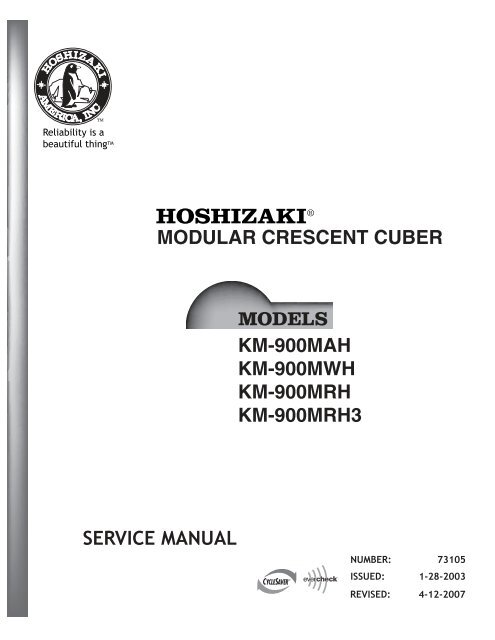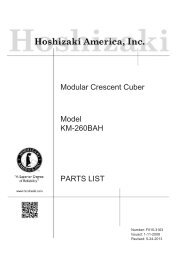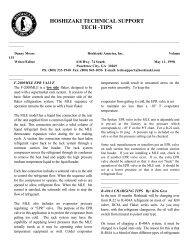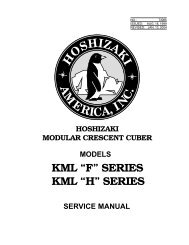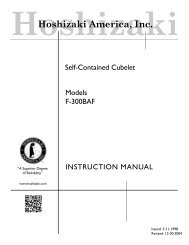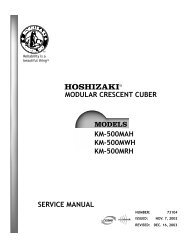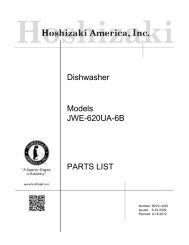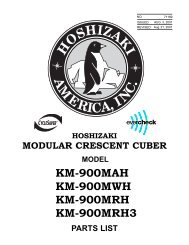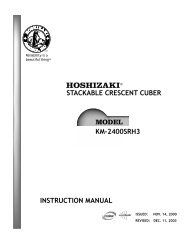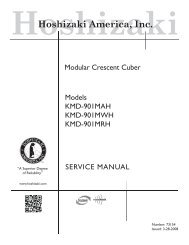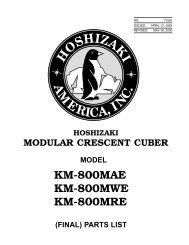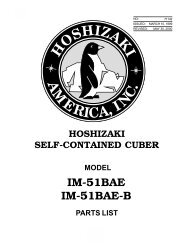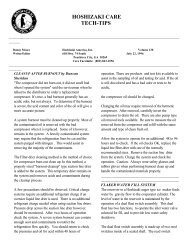6(59,&( 0$18$/ km-900mah km-900mwh km-900mrh km-900mrh3 ...
6(59,&( 0$18$/ km-900mah km-900mwh km-900mrh km-900mrh3 ...
6(59,&( 0$18$/ km-900mah km-900mwh km-900mrh km-900mrh3 ...
Create successful ePaper yourself
Turn your PDF publications into a flip-book with our unique Google optimized e-Paper software.
73105
IMPORTANTOnly qualified service technicians should attempt to service or maintain this icemaker.No service or maintenance should be undertaken until the technician has thoroughlyread this Service Manual.HOSHIZAKI provides this manual primarily to assist qualified service technicians in theservice and maintenance of the icemaker.Should the reader have any questions or concerns which have not been satisfactorilyaddressed, please call or write to the HOSHIZAKI Technical Support Department forassistance.HOSHIZAKI AMERICA, INC.618 Highway 74 SouthPeachtree City, GA 30269Attn: HOSHIZAKI Technical Support DepartmentPhone: 1-800-233-1940 Technical Service(770) 487-2331Fax: (770) 487-3360NOTE: To expedite assistance, all correspondence/communication MUST include thefollowing information:• Model Number• Serial Number• Complete and detailed explanation of the problem2
Please review this manual. It should be read carefully before the icemaker is servicedor maintenance operations are performed. Only qualified service technicians shouldservice and maintain the icemaker. This manual should be made available to thetechnician prior to service or maintenance.CONTENTSPAGEI. SPECIFICATIONS .................................................................................................... 51. KM-900MAH (Air-cooled) .................................................................................. 52a. KM-900MWH (Water-cooled), Serial # L00001D-M20500D ............................. 62b. KM-900MWH (Water-cooled), Serial # M30501D-- .......................................... 73. KM-900MRH (Remote air-cooled) .................................................................... 84. KM-900MRH3 (Remote air-cooled 3 phase) .................................................... 95. CONDENSING UNIT, URC-12F ..................................................................... 10II. GENERAL INFORMATION .................................................................................... 121. CONSTRUCTION ............................................................................................. 12[a] KM-900MAH (Air-cooled) ............................................................................ 12[b] KM-900MWH (Water-cooled) ..................................................................... 13[c] KM-900MRH (Remote air-cooled) ............................................................... 14[d] KM-900MRH3 (Remote air-cooled 3 phase) ............................................... 152. CONTROLLER BOARD .................................................................................... 16[a] SOLID-STATE CONTROL .......................................................................... 16[b] CONTROLLER BOARD .............................................................................. 16[c] SEQUENCE ................................................................................................ 20[d] CONTROLS AND ADJUSTMENTS ............................................................. 23[e] CHECKING CONTROLLER BOARD .......................................................... 273. MECHANICAL BIN CONTROL .......................................................................... 28[a] PROXIMITY SWITCH ................................................................................. 28[b] EXPLANATION OF OPERATION .............................................................. 28[c] TROUBLESHOOTING ................................................................................ 29III. TECHNICAL INFORMATION ............................................................................... 301. WATER CIRCUIT AND REFRIGERANT CIRCUIT............................................ 30[a] KM-900MAH (Air-cooled) ............................................................................ 30[b] KM-900MWH (Water-cooled) ..................................................................... 31[c] KM-900MRH (Remote air-cooled) ...................................................................and KM-900MRH3 (Remote air-cooled 3 phase)........................................ 322. WIRING DIAGRAMS ........................................................................................ 33[a] KM-900MAH (Air-cooled) ............................................................................ 33[b] KM-900MWH (Water-cooled) ..................................................................... 35[c] KM-900MRH (Remote air-cooled) ............................................................... 37[d] KM-900MRH3 (Remote air-cooled 3 phase) ............................................... 393. TIMING CHART ................................................................................................ 413
4. PERFORMANCE DATA ....................................................................................... 43[a] KM-900MAH (Air-cooled) ...............................................................................43[b] KM-900MWH (Water-cooled), Serial # L00001D-M20500D ..........................44[c] KM-900MWH (Water-cooled), Serial # M30501D--........................................ 45[d] KM-900MRH (Remote air-cooled) ................................................................. 46[e] KM-900MRH3 (Remote air-cooled 3 phase) ..................................................47IV. SERVICE DIAGNOSIS ........................................................................................... 481. NO ICE PRODUCTION........................................................................................ 482. EVAPORATOR IS FROZEN UP .......................................................................... 513. LOW ICE PRODUCTION ..................................................................................... 514. ABNORMAL ICE .................................................................................................. 525. OTHERS .............................................................................................................. 52V. REMOVAL AND REPLACEMENT OF COMPONENTS ........................................... 531. SERVICE FOR REFRIGERANT LINES ............................................................... 53[a] REFRIGERANT RECOVERY ......................................................................... 53[b] EVACUATION AND RECHARGE [R-404A] ................................................... 532. BRAZING ............................................................................................................. 543. REMOVAL AND REPLACEMENT OF COMPRESSOR ....................................... 554. REMOVAL AND REPLACEMENT OF DRIER ..................................................... 575. REMOVAL AND REPLACEMENT OF EXPANSION VALVE ............................... 576. REMOVAL AND REPLACEMENT OF HOT GAS VALVE AND................................LINE VALVE ....................................................................................................... 587. REMOVAL AND REPLACEMENT OF EVAPORATOR ........................................ 608. REMOVAL AND REPLACEMENT OF WATER-REGULATING VALVE ...................- WATER COOLED MODEL ONLY .................................................................... 619. ADJUSTMENT OF WATER-REGULATING VALVE.................................................- WATER COOLED MODEL ONLY .................................................................... 6210. REMOVAL AND REPLACEMENT OF CONDENSING PRESSURE .........................REGULATOR (C.P.R.) - REMOTE AIR-COOLED MODEL ONLY .................. 6311. REMOVAL AND REPLACEMENT OF THERMISTOR.......................................... 6412. REMOVAL AND REPLACEMENT OF FAN MOTOR ........................................... 6513. REMOVAL AND REPLACEMENT OF WATER VALVE ........................................ 6614. REMOVAL AND REPLACEMENT OF PUMP MOTOR ........................................ 6615. REMOVAL AND REPLACEMENT OF SPRAY TUBES ........................................ 67VI. MAINTENANCE AND CLEANING INSTRUCTIONS ............................................... 681. PREPARING THE ICEMAKER FOR LONG STORAGE ...................................... 682. CLEANING ........................................................................................................... 70[a] CLEANING PROCEDURE ............................................................................. 71[b] SANITIZING PROCEDURE ........................................................................... 723. MAINTENANCE ................................................................................................... 734
I. SPECIFICATIONS1. KM-900MAHAC SUPPLY VOLTAGE 208/230/60/1 (3 wire with neutral for 115V)AMPERAGE11 A ( 5 Min. Freeze AT 104°F / WT 80°F)MINIMUM CIRCUIT AMPACITY20 AMAXIMUM FUSE SIZE20 AAPPROXIMATE ICE PRODUCTION Ambient WATER TEMP. (°F)PER 24 HR. Temp.(°F) 50 70 90lbs./day ( kg/day ) 70 *838 (380) 804 (365) 7<strong>59</strong> (344)Reference without *marks 80 812 (368) 7<strong>59</strong> (344) 715 (324)90 804 (365) *721 (327) 676 (306)100 795 (361) 710 (322) 634 (288)SHAPE OF ICECrescent CubeICE PRODUCTION PER CYCLE14.3 lbs. ( 6.5 kg ) 720 pcs.APPROXIMATE STORAGE CAPACITY N/AELECTRIC & WATER CONSUMPTION 90/70°F 70/50°FELECTRIC W (kWH/100 lbs.) 1965 (6.6) 1783 (5.1)WATER gal./24HR (gal./100 lbs.) 244 (31.5) 472 (56.3)EXTERIOR DIMENSIONS (WxDxH) 30" x 27-3/8" x 37-7/16" (762 x 695 x 950 mm)EXTERIOR FINISHStainless Steel, Galvanized Steel (Rear)WEIGHTNet 216 lbs. ( 98 kg ), Shipping 282 lbs. (128 kg)CONNECTIONS - ELECTRICPermanent - Connection- WATER SUPPLY Inlet 1/2" FPT- DRAIN Outlet 3/4" FPT3/8" OD PipeCUBE CONTROL SYSTEMFloat SwitchHARVESTING CONTROL SYSTEM Hot Gas and Water, Thermistor and TimerICE MAKING WATER CONTROLTimer Controlled. Overflow PipeCOOLING WATER CONTROLN/ABIN CONTROL SYSTEMProximity Switch with DelayCOMPRESSOR Hermetic, Model CS14K6E-PFVCONDENSERAir-cooled, Fin and tube typeEVAPORATORVertical type, Stainless Steel and CopperREFRIGERANT CONTROLThermostatic Expansion ValveREFRIGERANT CHARGE R-404A, 3 lb. 7 oz. ( 1550 g )DESIGN PRESSUREHigh 467 PSIG, Low 230 PSIGP.C. BOARD CIRCUIT PROTECTION High Voltage Cut-out ( Internal )COMPRESSOR PROTECTION Auto-reset Overload Protector ( Internal )REFRIGERANT CIRCUIT PROTECTION Auto-reset High Pressure Control SwitchLOW WATER PROTECTIONFloat SwitchACCESSORIES -SUPPLIEDN/A-REQUIREDIce Storage BinOPERATING CONDITIONS VOLTAGE RANGE 187 - 253 VAMBIENT TEMP.45 -100° FWATER SUPPLY TEMP.45 - 90° FWATER SUPPLY PRESSURE10 - 113 PSIGWe reserve the right to make changes in specifications and design without prior notice.5
2a. KM-900MWHBeginning Serial No. L00001DEnding Serial No. M20500DAC SUPPLY VOLTAGE 208-230/60/1 (3 wire with neutral for 115 V)AMPERAGE10.2 AMINIMUM CIRCUIT AMPACITY15 AMAXIMUM FUSE SIZE15 AAPPROXIMATE ICE PRODUCTION Ambient WATER TEMP. (°F)PER 24 HR. Temp.(°F) 50 70 90lbs./day ( kg/day ) 70 *853 (387) 836 (379) 787 (357)Reference without *marks 80 840 (381) 813 (369) 750 (340)90 836 (379) 794 (360) 736 (334)100 818 (371) 780 (354) 683 (310)SHAPE OF ICECrescent CubeICE PRODUCTION PER CYCLE14.3 lbs. ( 6.5 kg ) 720 pcs.APPROXIMATE STORAGE CAPACITY N/AELECTRIC & WATER CONSUMPTION 90/70°F 70/50°FELECTRIC W (kWH/100 lbs.) 1775 (5.3) 1768 (5.0)WATER gal./24HR (gal./100 lbs.) 256 (32.2) 409 (47.9)WATER COOLED CONDENSER 1024 (129) 580 (68)gal./24HR (gal./100 lbs.)EXTERIOR DIMENSIONS (WxDxH) 30" x 27-3/8" x 37 7/16" (762 x 695 x 950 mm)EXTERIOR FINISHStainless Steel, Galvanized Steel (Rear)WEIGHT Net 211 lbs. ( 96 kg ), Shipping 277 lbs. ( 126 kg )CONNECTIONS - ELECTRICPermanent - Connection- WATER SUPPLY Inlet 1/2" FPT Condenser Inlet 1/2" FPT- DRAIN Outlet 3/4" FPT Condenser Outlet 3/8" FPT3/8" OD PipeCUBE CONTROL SYSTEMFloat SwitchHARVESTING CONTROL SYSTEM Hot Gas and Water, Thermistor and TimerICE MAKING WATER CONTROLTimer Controlled. Overflow PipeCOOLING WATER CONTROLPressure RegulatorBIN CONTROL SYSTEMProximity Switch with DelayCOMPRESSOR Hermetic, Model CS14K6E-PFVCONDENSERWater-cooled, Tube in tube typeEVAPORATORVertical type, Stainless Steel and CopperREFRIGERANT CONTROLThermostatic Expansion ValveREFRIGERANT CHARGE R-404A, 1 lb 7 oz. ( 650 g )DESIGN PRESSUREHigh 427 PSIG, Low 230 PSIGP.C. BOARD CIRCUIT PROTECTION High Voltage Cut-out ( Internal )COMPRESSOR PROTECTION Auto-reset Overload Protector ( Internal )REFRIGERANT CIRCUIT PROTECTION Auto-reset High Pressure Control SwitchLOW WATER PROTECTIONFloat SwitchACCESSORIES -SUPPLIEDN/A-REQUIREDIce Storage BinOPERATING CONDITIONS VOLTAGE RANGE 187 - 253 VAMBIENT TEMP.45 -100° FWATER SUPPLY TEMP.45 - 90° FWATER SUPPLY PRESSURE10 - 113 PSIGWe reserve the right to make changes in specifications and design without prior notice.6
2b. KM-900MWHBeginning Serial No. M30501DAC SUPPLY VOLTAGE 208-230/60/1 (3 wire with neutral for 115V)AMPERAGE10.2 A ( 5 Min. Freeze AT 104°F / WT 80°F)MINIMUM CIRCUIT AMPACITY15 AMAXIMUM FUSE SIZE15 AAPPROXIMATE ICE PRODUCTION Ambient WATER TEMP. (°F)PER 24 HR. Temp.(°F) 50 70 90lbs./day ( kg/day ) 70 *846 (384) 830 (376) 787 (357)Reference without *marks 80 833 (378) 808 (367) 754 (342)90 830 (376) *790 (358) 740 (336)100 814 (369) 778 (353) 694 (315)SHAPE OF ICECrescent CubeICE PRODUCTION PER CYCLE14.3 lbs. ( 6.5 kg ) 720 pcs.APPROXIMATE STORAGE CAPACITY N/AELECTRIC & WATER CONSUMPTION 90/70°F 70/50°FELECTRIC W (kWH/100 lbs.) 1700 (5.2) 1692 (4.8)WATER gal./24HR (gal./100 lbs.) 269 (34.0) 418 (49.4)WATER COOLED CONDENSER 916 (116) 491 (58)gal./24HR (gal./100 lbs.)EXTERIOR DIMENSIONS (WxDxH) 30" x 27-3/8" x 37 7/16" (762 x 695 x 950 mm)EXTERIOR FINISHStainless Steel, Galvanized Steel (Rear)WEIGHT Net 211 lbs. ( 96 kg ), Shipping 277 lbs. ( 126 kg )CONNECTIONS - ELECTRICPermanent - Connection- WATER SUPPLY Inlet 1/2" FPT Condenser Inlet 1/2" FPT- DRAIN Outlet 3/4" FPT Condenser Outlet 3/8" FPT3/8" OD PipeCUBE CONTROL SYSTEMFloat SwitchHARVESTING CONTROL SYSTEM Hot Gas and Water, Thermistor and TimerICE MAKING WATER CONTROLTimer Controlled. Overflow PipeCOOLING WATER CONTROLPressure RegulatorBIN CONTROL SYSTEMProximity Switch with DelayCOMPRESSOR Hermetic, Model CS14K6E-PFV-237CONDENSERWater-cooled, Tube in tube typeEVAPORATORVertical type, Stainless Steel and CopperREFRIGERANT CONTROLThermostatic Expansion ValveREFRIGERANT CHARGE R-404A, 1 lb. 14 oz. ( 850 g )DESIGN PRESSUREHigh 427 PSIG, Low 230 PSIGP.C. BOARD CIRCUIT PROTECTION High Voltage Cut-out ( Internal )COMPRESSOR PROTECTION Auto-reset Overload Protector ( Internal )REFRIGERANT CIRCUIT PROTECTION Auto-reset High Pressure Control SwitchLOW WATER PROTECTIONFloat SwitchACCESSORIES -SUPPLIEDN/A-REQUIREDIce Storage BinOPERATING CONDITIONS VOLTAGE RANGE 187- 253 VAMBIENT TEMP.45 -100° FWATER SUPPLY TEMP.45 - 90° FWATER SUPPLY PRESSURE10 - 113 PSIGWe reserve the right to make changes in specifications and design without prior notice.7
3. KM-900MRHAC SUPPLY VOLTAGE 208-230/60/1 (3 wire with neutral for 115V)AMPERAGE12.5 A ( 5 Min. Freeze AT 104°F / WT 80°F)MINIMUM CIRCUIT AMPACITY20 AMAXIMUM FUSE SIZE20 AAPPROXIMATE ICE PRODUCTION Ambient WATER TEMP. (°F)PER 24 HR. Temp.(°F) 50 70 90lbs./day ( kg/day ) 70 *835 (379) 817 (370) 786 (356)Reference without *marks 80 821 (372) 792 (3<strong>59</strong>) 758 (344)90 817 (370) *772 (350) 739 (335)100 808 (367) 764 (347) 708 (321)SHAPE OF ICECrescent CubeICE PRODUCTION PER CYCLE14.3 lbs. (6.5 kg ) 720 pcs.APPROXIMATE STORAGE CAPACITY N/AELECTRIC & WATER CONSUMPTION 90/70°F 70/50°FELECTRIC W (kWH/100 lbs.) 2060 (6.4) 2005 (6.0)WATER gal./24HR (gal./100 lbs.) 255 (33.0) 450 (53.9)EXTERIOR DIMENSIONS (WxDxH) 30" x 27-3/8" x 37-7/16" (762 x 695 x 950 mm)EXTERIOR FINISHStainless Steel, Galvanized Steel (Rear)WEIGHT Net 216 lbs. ( 98 kg ), Shipping 282 lbs. ( 128 kg )CONNECTIONS - ELECTRICPermanent - Connection- WATER SUPPLY Inlet 1/2" FPT- DRAIN Outlet 3/4" FPT3/8" OD PipeCUBE CONTROL SYSTEMFloat SwitchHARVESTING CONTROL SYSTEM Hot Gas and Water, Thermistor and TimerICE MAKING WATER CONTROLTimer Controlled. Overflow PipeCOOLING WATER CONTROLN/ABIN CONTROL SYSTEMProximity Switch with DelayCOMPRESSOR Hermetic, Model CS14K6E-PFVCONDENSERAir-cooled Remote, Condenser Unit URC 12FEVAPORATORVertical type, Stainless Steel and CopperREFRIGERANT CONTROLThermostatic Expansion ValveCondensing Pressure Regulator on URC-12FREFRIGERANT CHARGE R-404A, 9 lbs. 14 oz. ( 4500 g )( Icemaker 5 lbs. 8 oz. Cond. Unit 4 lb. 6 oz. )DESIGN PRESSUREHigh 467 PSIG, Low 230 PSIGP.C. BOARD CIRCUIT PROTECTION High Voltage Cut-out ( Internal )COMPRESSOR PROTECTION Auto-reset Overload Protector ( Internal )REFRIGERANT CIRCUIT PROTECTION Auto-reset High Pressure Control SwitchLOW WATER PROTECTIONFloat SwitchACCESSORIES -SUPPLIEDN/A-REQUIREDIce Storage Bin, Remote Condenser UnitOPERATING CONDITIONS VOLTAGE RANGE 187 - 253 VAMBIENT TEMP.45 -100° FWATER SUPPLY TEMP.45 - 90° FWATER SUPPLY PRESSURE10 - 113 PSIGWe reserve the right to make changes in specifications and design without prior notice.8
4. KM-900MRH3AC SUPPLY VOLTAGE 208-230/60/3AMPERAGE6.5 A ( 5 Min. Freeze AT 104°F / WT 80°F)MINIMUM CIRCUIT AMPACITY20 AMAXIMUM FUSE SIZE20 AAPPROXIMATE ICE PRODUCTION Ambient WATER TEMP. (°F)PER 24 HR. Temp.(°F) 50 70 90lbs./day ( kg/day ) 70 *842 (382) 826 (375) 784 (356)Reference without *marks 80 830 (377) 806 (366) 753 (341)90 826 (375) *789 (358) 739 (335)100 811 (368) 777 (353) 694 (315)SHAPE OF ICECrescent CubeICE PRODUCTION PER CYCLE14.3 lbs. (6.5 kg ) 720 pcs.APPROXIMATE STORAGE CAPACITY N/AELECTRIC & WATER CONSUMPTION 90/70°F 70/50°FELECTRIC W (kWH/100 lbs.) 2070 (6.3) 2000 (5.7)WATER gal./24HR (gal./100 lbs.) 264 (33.4) 454 (53.9)EXTERIOR DIMENSIONS (WxDxH) 30" x 27-3/8" x 37-7/16" (762 x 695 x 950 mm)EXTERIOR FINISHStainless Steel, Galvanized Steel (Rear)WEIGHT Net 216 lbs. ( 98 kg ), Shipping 282 lbs. ( 128 kg )CONNECTIONS - ELECTRICPermanent - Connection- WATER SUPPLY Inlet 1/2" FPT- DRAIN Outlet 3/4" FPT3/8" OD PipeCUBE CONTROL SYSTEMFloat SwitchHARVESTING CONTROL SYSTEM Hot Gas and Water, Thermistor and TimerICE MAKING WATER CONTROLTimer Controlled. Overflow PipeCOOLING WATER CONTROLN/ABIN CONTROL SYSTEMProximity Switch with DelayCOMPRESSOR Hermetic, Model CS14K6E-TF5CONDENSERAir-cooled Remote, Condenser Unit URC 12FEVAPORATORVertical type, Stainless Steel and CopperREFRIGERANT CONTROLThermostatic Expansion ValveCondensing Pressure Regulator on URC-12FREFRIGERANT CHARGE R-404A, 9 lbs. 14 oz. ( 4500 g )( Icemaker 5 lbs. 8 oz. Cond. Unit 4 lb. 6 oz. )DESIGN PRESSUREHigh 467 PSIG, Low 230 PSIGP.C. BOARD CIRCUIT PROTECTION High Voltage Cut-out ( Internal )COMPRESSOR PROTECTION Auto-reset Overload Protector ( Internal )REFRIGERANT CIRCUIT PROTECTION Auto-reset High Pressure Control SwitchLOW WATER PROTECTIONFloat SwitchACCESSORIES -SUPPLIEDN/A-REQUIREDIce Storage Bin, Remote Condenser UnitOPERATING CONDITIONS VOLTAGE RANGE 187 - 253 VAMBIENT TEMP.45 -100° FWATER SUPPLY TEMP.45 - 90° FWATER SUPPLY PRESSURE10 - 113 PSIGWe reserve the right to make changes in specifications and design without prior notice.9
5. CONDENSING UNITURC-12F10
SPECIFICATIONSMODEL: URC-12FEXTERIORDIMENSIONS (W x D x H)Galvanized Steel35 - 11/16” x 15-11/16” x 21-15/16”(907.2 x 398 x 557.8 mm)REFRIGERANT CHARGEWEIGHTURC-12FCONNECTIONSREFRIGERANTELECTRICALCONDENSERHEAD PRESSURE CONTROLAMBIENT CONDITIONR404A 4 lbs. 7 oz. (2000 g)Net 80 lbs. (36 kg)Shipping 87 lbs. (39 kg)One Shot Couplings (Aeroquip)Permanent ConnectionAir-cooledCondensing Pressure RegulatorMin. -20°F - Max. +122°F(-29°C to +50°C)Outdoor use11
II. GENERAL INFORMATION1. CONSTRUCTION[a] KM-900MAHModels with ThermostatModels with Mechanical Bin Control12
[b] KM-900MWHModels with ThermostatModels with Mechanical Bin Control13
[c] KM-900MRHModels with ThermostatModels with Mechanical Bin Control14
[d] KM-900MRH3Models with ThermostatModels with Mechanical Bin Control15
2. CONTROLLER BOARD[a] SOLID-STATE CONTROL1) A HOSHIZAKI exclusive solid-state control is employed in KM-900MAH,KM-900MWH, KM-900MRH and KM-900MRH3 Modular Crescent Cubers.2) A Printed Circuit Board (hereafter called “Controller Board”) includes a stable andhigh quality control system.3) All models are pretested and factory-adjusted.[b] CONTROLLER BOARD1. Fragile, handle very carefully.CAUTION2. A controller board contains integrated circuits, which are susceptible tofailure due to static discharge. It is especially important to touch themetal part of the unit when handling or replacing the board.3. Do not touch the electronic devices on the board or the back of theboard to prevent damage to the board.4. Do not change wiring and connections. Do not misconnect K3, K4 andK5, because the same connector is used for the Thermistor (white),Float Switch (black), and Mechanical Bin Control (red).(For machines with thermostat, there is no connection on K4.)5. Always replace the whole board assembly when it goes bad.6. Do not short out power supply to test for voltage.PART NUMBERTYPE2A1410-01 HOS-001A (Control Products)Features of Control Products “E” Controller Board1) Maximum Water Supply Period - 6 minutesWater Solenoid Valve opening, in the Defrost (Harvest) Cycle, is limited by the defrosttimer. The Water Valve cannot remain open longer than the maximum period.The Water Valve can close in less than six minutes if the defrost cycle is completed.16
2) Defrost TimerThe defrost cycle starts when the Float Switch opens and completes the freeze cycle.But the Defrost Timer does not start counting until the Thermistor senses 48°F at theEvaporator outlet. The period from the end of the freeze cycle up to the point of theThermistor's sensing varies depending on the ambient and water temperatures.3) High Temperature Safety - 127 ± 7°FThe temperature of the suction line in the refrigerant circuit is limited by the HighTemperature Safety.During the defrost cycle the Evaporator temperature rises. The Thermistorsenses 48°F and starts the Defrost Timer. After the Defrost Timer counts downto zero, the normal freeze cycle begins. If the Evaporator temperature continuesto rise, the Thermistor will sense the rise in temperature and at 127 ± 7°F theThermistor operates the High Temperature Safety.This High Temperature Safety shuts down the circuit and the icemaker automaticallystops.This High Temperature Safety protects the unit from excessive temperature. The ControlBoard will Beep every 3 seconds. The white Reset Button on the Control Board must bepressed with power on to reset the Safety.4) Low Water SafetyIf the Pump Motor is operated without water, the mechanical seal can fail. To preventthis type of failure, the Controller Board checks the position of the Float Switch at the endof the initial one minute water fill cycle and at the end of each defrost cycle.If the Float Switch is in the up position (electrical circuit closed), the Controller Boardchanges to the ice making cycle. If the Float Switch is in the down position (electricalcircuit open), the Controller Board changes to a one minute water fill cycle before startingthe ice making cycle. This method allows for a Low Water Safety shut down to protectthe Water Pump from mechanical seal failure.For water-cooled model, if the water is shut off, the unit is protected by the High PressureSwitch.5) High Voltage CutoutThe maximum allowable supply voltage of this icemaker is limited by the High Voltage Cutout.If miswiring (especially on single phase 3 wire models) causes excessive voltage on theController Board, the High Voltage Cutout shuts down the circuit in 3 seconds and theicemaker automatically stops. When the proper supply voltage is resumed, the icemakerautomatically starts running again. The Control Board will signal this problem using 7 Beepsevery 3 seconds.6) LED Lights and Audible Alarm SafetiesThe red LED indicates proper control voltage and will remain on unless a control voltageproblem occurs. At startup a 5 second delay occurs while the board conducts an internaltimer check. A short beep occurs when the power switch is turned ON or OFF.17
The green LED’s 1-4 represent the corresponding relays and energize and sequence 5seconds from initial start-up as follows:Sequence Step LED’s on Length: Min. Max. Avg.1 Minute Fill Cycle LED4 60 sec.Harvest Cycle LED1, 4, & 2 2 min. 20 min. 3-5 min.Freeze Cycle LED1 5 min. 60 min. 30-35 min.Reverse Pump Out LED1, 3, & 2 10 sec. 20 sec. Factory set.{LED 1 – Comp; LED 2 - HGV/CFM; LED 3 – PM; LED 4 - WV}The built in safeties shut down the unit and have alarms as follows:1 beep every 3 sec. = High Evaporator Temperature >127 ° F.Check for defrost problem (stuck HGV or relay), hot water entering unit, stuckheadmaster, or shorted thermistor.2 beeps every 3 sec. = Defrost Back Up Timer. Defrost >20 minutes.Orange LED marked 20 MIN energizes.Check for open thermistor, HGV not opening, TXV leaking by, low charge, or inefficientcompressor.3 beeps every 3 sec. = Freeze Back Up Timer. Freeze > 60 minutes.Yellow LED marked 60 MIN energizes.Check for F/S stuck closed (up), WV leaking by, HGV leaking by, TXV not feedingproperly, low charge, or inefficient compressor.Machineswithmechanicalbin controlONLY4 beeps every 3 sec. = Short Circuit between the K4 connection onthe control board and the bin control relay. Check connections andreplace wire harness if necessary.5 beeps every 3 sec. = Open Circuit between the K4 connectionon the control board and the bin control relay. Check connections andreplace wire harness if necessary.To manually reset the above safeties, depress white alarm reset button with the powersupply ON.6 beeps every 3 sec. = Low Voltage. Voltage is 92 Vac or less.7 beeps every 3 sec. = High Voltage. Control voltage > 147 Vac ±5%.The red LED will de-energize if voltage protection operates.The voltage safety automatically resets when voltage is corrected.The Output Test switch “S3” provides a relay sequence test. With power OFF, place S3ON and switch power to ICE. The correct lighting sequence should be none, 2, 3, 4, 1, &4, normal sequence every 5 seconds. S3 should remain in the “OFF” position for normaloperation.18
The application switch located between relay X3 & X4 must be set to match the originalboard application. Place this switch in the ALP position if there is no white wire suppliedto the K1 connector. If there is a white wire, place the switch in the C position. If thisswitch is placed in the wrong position, either the compressor contactor will remain energizedwith the control switch OFF, or the unit will not start.The dip switches should be adjusted per the adjustment chart published in the TechSpecs book. Number 8 must remain in the OFF position.(Control Products HOS-001A Board)19
[c] SEQUENCE1st Cycle1. Unit energized and Control Switch to “ICE”position. Water supply cycle starts.3. Thermistor reads 48° F.Defrost Timer starts counting.2. After 1 minute,Defrost cycle starts.&IMPORTANTWater Valveopening is limitedto 6 minutes.5. After the first 5 minutes in freeze cycle.Ready to complete freeze cycle when FloatSwitch circuit opens.IMPORTANTBoard never accepts freeze completion signalwithin the first 5 minutes in freeze cycle.4. Defrost Timer stops counting.Defrost cycle is completed and freeze cyclestarts.IMPORTANT1. Board never accepts defrost completionsignal within the first 2 minutes in defrostcycle.2. Defrost cycle time is limited to 20 minuteseven if Defrost Timer does not stop counting.20
2nd Cycle and after with pump drainIMPORTANTFreeze cycle time is limited to 60 minutes evenif Float Switch does not open.1. Float Switch opens and signals to completefreeze cycle.Drain timer starts counting.2. Drain timer stops counting.Pump drain is completed3. Thermistor reads 48° F.Defrost Timer startscounting.&IMPORTANTWater Valveopening is limited to 6minutes.5. After the first 5 minutes in freeze cycle.Ready to complete freeze cycle when FloatSwitch circuit opens.4. Defrost Timer stops counting.Defrost cycle is completed and freeze cyclestarts.IMPORTANTBoard never accepts freeze completion signalwithin the first 5 minutes in freeze cycle.IMPORTANT1. Board never accepts defrost completionsignal within the first 2 minutes in defrostcycle.2. Defrost cycle time is limited to 20 minuteseven if Defrost Timer does not stop counting.21
2nd Cycle and after with no pump drainIMPORTANTFreeze cycle time is limited to 60 minutes evenif Float Switch does not open.1. Float Switch opens and signals to completefreeze cycle.2. Thermistor reads 48° F.Defrost Timer starts counting.&IMPORTANTWater Valveopening is limited to 6minutes.4. After the first 5 minutes in freeze cycle.Ready to complete freeze cycle when FloatSwitch circuit opens.IMPORTANTBoard never accepts freeze completion signalwithin the first 5 minutes in freeze cycle.3. Defrost Timer stops counting.Defrost cycle is completed and freeze cyclestarts.IMPORTANT1. Board never accepts defrost completionsignal within the first 2 minutes in defrostcycle.2. Defrost cycle time is limited to 20 minuteseven if Defrost Timer does not stop counting.22
[d] CONTROLS AND ADJUSTMENTSThe Dip Switch is factory-adjusted to the following positions:FOR MODELS WITH MECHANICAL BIN CONTROL:DIP SWITCH NO. 1 2 3 4 5 6 7 8 9 10KM-900MRH/3 OFF OFF ON OFF ON ON ON OFF OFF ONKM-900MAH, OFF OFF ON OFF ON ON ON OFF OFF ONKM-900MWHFOR MODELS WITH THERMOSTAT :DIP SWITCH NO. 1 2 3 4 5 6 7 8 9 10KM-900MRH/3 OFF OFF ON OFF ON ON OFF OFF OFF ONKM-900MAH, OFF OFF ON OFF ON ON OFF OFF OFF ONKM-900MWHSwitch Nos. 1 and 2:Used for adjustment of the Defrost Timer.The Defrost Timer starts counting when the Thermistor reads a certain temperatureat the Evaporator outlet.Switch Nos. 3 and 4:Used for adjustment of the Drain Timer.When a freeze cycle is completed, the Pump Motor stops, and the icemakerresumes operation in 2 seconds. Then the Pump Motor drains the Water Tankfor the time determined by the Drain Timer. The Drain Timer also determines thetime to restrain completion of a defrost cycle, i.e. the minimum defrost time.Switch Nos. 5 and 6:Used for adjustment of the Drain Counter.The Pump Motor drains the Water Tank at the frequency determined by the DrainCounter.Switch No. 7:Used only on models with mechanical bin control. Dip Switch should be set“ON”.(Models with bin thermostat, Switch No. 7 should be set in the “OFF” position.)Switch No. 8:Used only for checking the Controller Board. Usually set in OFF position.23
Switch Nos. 9 and 10:Used for adjustment of Freeze Timer.The Freeze Timer determines maximumfreeze cycle time. Upon termination ofFreeze Timer, machine initiates theharvest cycle. After 2 consecutive timerterminations, machine will shut down,possibly indicating a problem.1) Defrost ControlA thermistor (Semiconductor) is used for a defrost control sensor. The resistancevaries depending on the Suction Line temperatures. The Thermistor detects thetemperature of the Evaporator outlet to start the Defrost Timer. No adjustment isrequired. If necessary, check for resistance between Thermistor leads, and visuallycheck the Thermistor mounting, located on the Suction Line next to the Evaporatoroutlet.Temperature (°F)Resistance (kΩ)0 14.40110 10.61332 6.00050 3.87170 2.47490 1.633Check a thermistor for resistance by using the following procedures.(i) Disconnect the connector K3 on the board.(ii)Remove the Thermistor. See “V. 11. REMOVAL AND REPLACEMENT OFTHERMISTOR.”(iii) Immerse the Thermistor sensor portion in a glass containing ice and water for 2 or 3minutes.(iv)Check for a resistance between Thermistor leads.Normal reading is within 3.5 to 7 kΩ. Replace the Thermistor if it exceeds the normalreading.24
2) Defrost TimerNo adjustment is required under normal use, as the Defrost Timer is adjusted to the suitableposition. However, if necessary when all the ice formed on the Evaporator does notfall into the bin in the harvest cycle, adjust the Defrost Timer to longer setting by adjustingthe Dip Switch (No. 1 & 2) on the Controller Board.SETTINGDip Switch Dip SwitchNo. 1 No. 2TIMEOFF OFF 60 secondsON OFF 90 secondsOFF ON 120 secondsON ON 180 seconds3) Drain TimerThe Drain Timer is factory-adjusted, and no adjustment is required.SETTINGTIMEDip Switch Dip SwitchNo. 3 No. 4 T1 T2OFF OFF 10 seconds 150 secondsON OFF 10 seconds 180 secondsOFF ON 10 seconds 120 secondsON ON 20 seconds 180 secondsT1: Time to drain the Water TankT2: Time to restrain defrost completion4) Drain CounterCAUTIONDo not adjust the Drain Counter, or the Evaporator may freeze up.The Drain Counter is factory-adjusted to drain the Water Tank every 10 cycles, and noadjustment is required. However, where water quality is bad and the icemaker needs apump drain more often, the Drain Counter can be adjusted as shown in the table below:25
SETTINGDip Switch Dip SwitchNo. 5 No. 6FREQUENCYOFF OFF every cycleON OFF every 2 cyclesOFF ON every 5 cyclesON ON every 10 cycles5) Freeze TimerCAUTIONAdjust to proper specification, or the unit may not operate correctly.Two new dip switches numbered 9 and 10 have been added to the improved “E”board to better prevent possible freeze ups. These settings come factory set to thedefault setting of 60 min. (OFF, OFF). Check the adjustment chart published in theTech Specs for proper settings. If the old board does not have these two dipswitches, (only 8 instead of 10), leave setting as OFF, OFF.SETTINGDip Switch Dip SwitchNo. 9 No. 10TIMEOFF OFF 60 min.ON OFF 70 min.OFF ON 50 min.ON ON 60 min.6) Bin ControlMODELS WITH THERMOSTATCAUTIONWhen the ambient temperature is below 45°F, the Bin Control Thermostatoperates to stop the icemaker even if the Ice Storage Bin is empty.When the Thermostat is set in the prohibited range, the icemaker operatescontinuously even if the Ice Storage Bin is filled with ice. Setting inthe prohibited range might cause severe damage to the icemaker resultingin failure.No adjustment is required under normal use, as the Bin Control is factory-adjusted.Adjust it, if necessary, so that the icemaker stops automatically within 10 seconds afterice contacts the Bin Control Thermostat Bulb.26
MODELS WITH MECHANICAL BIN CONTROLCAUTIONDip Switch No. 7 must be set to the ON position. If No. 7 is set to the OFFposition, the machine will run continuously, causing a freeze-up condition.No adjustment is required. The Bin Control is factory-adjusted.[e] CHECKING THE CONTROLLER BOARD1) Visually check the sequence with the icemaker operating.2) Visually check the Controller Board by using the following procedures.(i) Adjust the Defrost Timer to minimum position.Disconnect the Thermistor from the Controller Board.Connect a 1.5 kΩ - 3.5 kΩ resistor to the Connector K3 (pins #1 and #2), and energizethe unit.After the 1 minute ± 5 second water supply cycle and the 2 minute ± 10 second defrostcycle, the unit should start the freeze cycle.(ii)After the above step (i), disconnect the Float Switch leads from the Controller Boardwithin the first 5 minutes of the freeze cycle.The unit should go into the defrost cycle after the first 5 minutes ± 20 seconds ofthe freeze cycle.(iii) Reconnect the Float Switch Connector to the Controller Board. After the first 5minutes of the freeze cycle, disconnect the Float Switch leads from the ControllerBoard.At this point, the unit should start the defrost cycle.(iv)After Step (iii), de-energize the unit and confirm that the Defrost Timer is in theminimum position. Disconnect the resistor from the Controller Board, and energizethe unit.After the 1 minute water supply cycle, the defrost cycle starts.Reconnect a 1.5 kΩ - 3.5 kΩ resistor to the Connector K3 (pins #1 and #2) afterthe first 2 minutes of the defrost cycle.The unit should start the freeze cycle after 1 minute ± 5 seconds from the resistorconnection.27
3) Check the Controller Board by using test program of the Controller Board.The Output Test Switch “S3” provides a relay sequence test. With power OFF, place S3 onand switch power to ICE. The correct lighting sequence should be none, 2, 3, 4, 1, and 4,normal sequence every 5 seconds. S3 should remain in the “OFF” position for normaloperation.3. MECHANICAL BIN CONTROL(THESE INSTRUCTIONS NOT APPLICABLE TO MODELS WITH THERMOSTAT)[a] PROXIMITY SWITCH1) This machine uses a lever-actuated proximity switch (hereafter called “mechanical bincontrol”) to control the ice level in the storage bin.[b] EXPLANATION OF OPERATION1) The startup and shutdown of the ice machine is controlled via the controller board. DipSwitch number 7 must be in the ON position for the controller board to receive input fromthe bin control.(i) The controller board receives a resistance value input via the red K4 connectorfrom the bin control. A resistor wire harness is connected from the bin control tothe controller board.(ii) When the bin control is activated in the bin full position (pushed to the right), a15.8 KΩ signal will be sent to the control board to shut down the unit.(iii) When the bin control is in the normal position (bin is not full), a 7.9 KΩ reading issent to the control board to continue operation.2) During operation, the controller board will only shut down the machine if a 15.8 KΩ signal isreceived from the bin control during the first 5 minutes of the freeze cycle.(i) If ice pushes the lever to the right after the first five minutes of the freeze cycle,the controller board will allow the machine to complete the freeze cycle and thefollowing harvest cycle before shutting down the machine. This will preventincomplete batches of ice from forming on the evaporator.28
[c] TROUBLESHOOTING (MECHANICAL BIN CONTROL ONLY)1) Machine will not start(i) Move dip switch No. 7 to the “OFF” position. If the machine starts up within a fewseconds, the bin control is the likely problem. If the machine does not start up,refer to Section “IV. Service Diagnosis” to verify that non-bin control related issuesare resolved.(ii) Check to make sure shipping tape has been removed and the wires are connectedproperly.(iii) Check to make sure no obstruction prevents the lever from moving to the bin emptyposition.2) Machine will not shut off(i) Refer to Section “IV. Service Diagnosis” to verify that non-bin control related issuesare resolved.(ii) Dip switch No. 7 should be in the on position. If the switch is in the off position, thecontroller board will not receive input from the bin control.(iii) Move the lever to the far right.a. If the machine does not shut off, check the resistance values of the resistorwire harness. You should read approximately 15.8 KΩ between the blackterminal and the red terminal that connect to the K4 connector on the controllerboard, when the lever is in the bin full position (far right). If this readsapproximately 7.9 KΩ, the resistors may be miswired. Switch the black andwhite wires in the terminal housing or order a replacement wire harness.b. Check the stainless steel bracket that the bin control is mounted to.c. If the preceding items do not resolve the problem, replace the Bin ControlAssembly.29
III. TECHNICAL INFORMATION1. WATER CIRCUIT AND REFRIGERANT CIRCUIT[a] KM-900MAH30
[b] KM-900MWH31
[c] KM-900MRH and KM-900MRH332
2. WIRING DIAGRAMS[a] KM-900MAH (With Mechanical Bin Control, Aux. Codes L-0 through M-1)Note: Pressure SwitchCut-out 412 ±210PSIGCut-in 327 ± 21 PSIG33
KM-900MAH (With Thermostat, Aux. Codes M-2 and after)Note: Pressure SwitchCut-out 412 ±210PSIGCut-in 327 ± 21 PSIG34
[b] KM-900MWH (With Mechanical Bin Control, Aux. Codes L-0 through M-3)Note: Pressure SwitchCut-out 384 ±210PSIGCut-in 284 ± 21 PSIG35
KM-900MWH (With Thermostat, Aux. Codes M-4 and after)Note: Pressure SwitchCut-out 384 ±210PSIGCut-in 284 ± 21 PSIG36
[c] KM-900MRH (With Mechanical Bin Control, Aux. Codes L-0 through M-1)Note: Pressure SwitchCut-out 412 ±210PSIGCut-in 327 ± 21 PSIG37
KM-900MRH (With Thermostat, Aux. Codes M-2 and after)Contactor appearance changed during 2006.Earlier style is shown here, and new style isshown above in the wiring diagram.Note: Pressure SwitchCut-out 412 ±210PSIGCut-in 327 ± 21 PSIG38
[d] KM-900MRH3 (With Mechanical Bin Control, Aux. Codes L-0 through M-0)Note: Pressure SwitchCut-out 412 ±210PSIGCut-in 327 ± 21 PSIG39
KM-900MRH3 (With Thermostat, Aux. Codes M-1 and after)Note: Pressure SwitchCut-out 412 ±210PSIGCut-in 327 ± 21 PSIG40
3. TIMING CHART41
4. PERFORMANCE DATA[a] KM-900MAHAPPROXIMATE ICEPRODUCTION PER 24 HR.AMBIENT TEMP.WATER TEMP. (ºF/ºC)(ºF/ºC) 50/10 70/21 90/3270/21 838 380 804 365 7<strong>59</strong> 34480/27 812 368 7<strong>59</strong> 344 715 32490/32 804 365 721 327 676 306lbs./day kg./day 100/38 795 361 710 322 634 288APPROXIMATE ELECTRICCONSUMPTION70/2180/2790/32178318241860183619071965186019201973watts 100/38190019671980APPROXIMATE WATER70/21 472 1.79 405 1.53 356 1.35CONSUMPTION PER 24 HR. 80/27 421 1.<strong>59</strong> 317 1.20 292 1.1090/32 410 1.55 244 0.92 208 0.79gal./day m 3 /day 100/38 405 1.53 235 0.89 174 0.66FREEZING CYCLE TIME70/2180/2790/32212222222426252729min.HARVEST CYCLE TIME100/3870/21234.5273.9313.580/2790/32min. 100/38HEAD PRESSURE3.92.42.070/21 245 17.2 267 18.8 296 20.880/27 262 18.4 296 20.8 324 22.790/32 267 18.8 320 22.5 349 24.5PSIG kg/cm 2 G 100/38 272 19.1 327 23.0 375 26.4SUCTION PRESSURE70/21 33 2.3 36 2.5 40 2.880/27 35 2.5 39 2.7 43 3.090/32 36 2.5 42 3.0 46 3.2PSIG kg/cm 2 G 100/38 37 2.6 43 3.0 50 3.54.14.03.12.53.02.2TOTAL HEAT OF REJECTION FROM CONDENSER14800 BTU/h [AT 90ºF (32ºC) / WT 70ºF (21ºC)]Note: Pressure data is recorded at 5 minutes into freeze cycle. The data not in bold should be used forreference only.We reserve the right to make changes in specifications and design without prior notice.43
[b] KM-900MWHMODEL: KM-900 MWHBeginning Serial No. L00001DEnding Serial No. M20500DAPPROXIMATE ICEPRODUCTION PER 24 HR.70/21 853 387 836 379 787 35780/27 840 381 813 369 750 34090/32 836 379 794 360 736 334lbs./day kg./day 100/38 818 371 780 354 683 310APPROXIMATE ELECTRIC 70/21CONSUMPTION80/2790/32watts 100/38177317771793APPROXIMATE WATER70/21 989 3.74 1074 4.07 1362 5.16CONSUMPTION PER 24 HR. 80/27 1054 3.99 1186 4.49 1570 5.9490/32 1074 4.07 1280 4.85 1629 6.17gal./day m 3 /day 100/38 1190 4.50 1362 5.16 1950 7.38FREEZING CYCLE TIME70/2180/2721212222232<strong>59</strong>0/32min. 100/38HARVEST CYCLE TIME70/2180/2790/32min. 100/38HEAD PRESSUREAMBIENT TEMP.WATER TEMP. (ºF/ºC)(ºF/ºC) 50/10 70/21 90/3217681770177022223.53.33.217701773177523233.22.82.51778178317843.22.42.070/21 278 19.5 280 19.7 290 20.480/27 280 19.7 283 19.9 297 20.990/32 280 19.7 285 20.0 298 21.0PSIG kg/cm 2 G 100/38 285 20.0 288 20.3 310 21.8SUCTION PRESSURE70/21 37 2.6 38 2.7 41 2.980/27 38 2.7 40 2.8 43 3.090/32 38 2.7 42 3.0 45 3.1PSIG kg/cm 2 G 100/38 39 2.7 43 3.0 47 3.325272.92.62.2TOTAL HEAT OF REJECTION FROM CONDENSERTOTAL HEAT OF REJECTION FROM COMPRESSORWATER FLOW FOR CONDENSERPRESSURE DROP OF COOLING WATER LINE14400 BTU/h [AT 90ºF (32ºC) / WT 70ºF (21ºC)]2445 BTU/h [AT 90ºF (32ºC) / WT 70ºF (21ºC)]79 gal. / h (AT 100ºF (38ºC) / WT 90ºF (32ºC))less than 10 PSIGNote: Pressure data is recorded at 5 minutes into freeze cycle. The data not in bold should be used forreference only.We reserve the right to make changes in specifications and design without prior notice.44
[c] KM-900MWHBeginning Serial No. M30501DAPPROXIMATE ICEAMBIENT TEMP.WATER TEMP. (ºF/ºC)PRODUCTION PER 24 HR. (ºF/ºC) 50/1070/21 90/3270/21 *846 384 830 376 787 35780/27 833 378 808 367 754 34290/32 830 376 *790 358 740 336lbs./day kg./day 100/38 814 369 778 353 *694 315APPROXIMATE ELECTRICCONSUMPTION70/2180/2790/32*16921694169416941697*1700169717011703watts 100/3816951701*1706APPROXIMATE WATER70/21 *909 3.44 990 3.75 1150 4.35CONSUMPTION PER 24 HR. 80/27 971 3.67 1164 4.41 1284 4.8690/32 990 3.75 *1185 4.49 1365 5.17gal./day m 3 /day 100/38 1185 4.49 1365 5.17 *1530 5.79FREEZING CYCLE TIME70/2180/2790/32*2121222222*23232525min.HARVEST CYCLE TIME100/3870/2122*3.9233.5*273.280/2790/32min. 100/38HEAD PRESSURE3.52.4*2.070/21 *280 19.7 280 19.7 288 20.280/27 280 19.7 280 19.7 292 20.<strong>59</strong>0/32 280 19.7 *280 19.7 290 20.4PSIG kg/cm 2 G 100/38 284 20.0 284 20.0 300 21.1SUCTION PRESSURE70/21 *36 2.5 38 2.7 39 2.780/27 38 2.6 41 2.9 41 2.990/32 38 2.7 *43 3.0 44 3.1PSIG kg/cm 2 G 100/38 38 2.6 43 3.0 *44 3.13.63.52.9*2.42.82.2TOTAL HEAT OF REJECTION FROM CONDENSERTOTAL HEAT OF REJECTION FROM COMPRESSORWATER FLOW FOR CONDENSERPRESSURE DROP OF COOLING WATER LINE13000 BTU/h [AT 90ºF (32ºC) / WT 70ºF (21ºC)]2465 BTU/h [AT 90ºF (32ºC) / WT 70ºF (21ºC)]56 gal. / h (AT 100ºF (38ºC) / WT 90ºF (32ºC))less than 10 PSIGNote: Pressure data is recorded at 5 minutes into freeze cycle. The data not in bold should be used forreference only.We reserve the right to make changes in specifications and design without prior notice.45
[d] KM-900MRHAPPROXIMATE ICEPRODUCTION PER 24 HR.70/21 835 379 817 370 786 35680/27 821 372 792 3<strong>59</strong> 758 34490/32 817 370 772 350 739 335lbs./day kg./day 100/38 808 367 764 347 708 321APPROXIMATE ELECTRIC 70/21CONSUMPTION80/2790/32watts 100/38AMBIENT TEMP.WATER TEMP. (ºF/ºC)(ºF/ºC) 50/10 70/21 90/32200520172021202120422060203420502070202120622080APPROXIMATE WATER70/21 450 1.70 393 1.49 347 1.31CONSUMPTION PER 24 HR. 80/27 406 1.54 318 1.20 290 1.1090/32 393 1.49 255 0.97 219 0.83gal./day m 3 /day 100/38 321 1.21 246 0.93 185 0.70FREEZING CYCLE TIME 70/2180/2790/32212222222324242526min.HARVEST CYCLE TIME100/3870/2180/2790/32224.54.13.9243.93.12.5283.53.02.2min. 100/383.22.42.0HEAD PRESSURE70/21 220 15.5 233 16.4 255 17.980/27 230 16.2 251 17.6 274 19.390/32 233 16.4 265 18.6 288 20.3PSIG kg/cm 2 G 100/38 239 16.8 270 19.0 310 21.8SUCTION PRESSURE70/21 32 2.2 34 2.4 37 2.680/27 34 2.4 37 2.6 40 2.890/32 34 2.4 40 2.8 43 3.0PSIG kg/cm 2 G 100/38 35 2.4 41 2.9 45 3.2TOTAL HEAT OF REJECTION FROM CONDENSERTOTAL HEAT OF REJECTION FROM COMPRESSORCONDENSER VOLUME13815 BTU/h [AT 90ºF (32ºC) / WT 70ºF (21ºC)]2350 BTU/h [AT 90ºF (32ºC) / WT 70ºF (21ºC)]132 CU. IN (URC-12F)Note: Pressure data is recorded at 5 minutes into freeze cycle. The data not in bold should be used forreference only.We reserve the right to make changes in specifications and design without prior notice.46
[e] KM-900MRH3APPROXIMATE ICEPRODUCTION PER 24 HR.70/21 842 382 826 375 784 35680/27 830 377 806 366 753 34190/32 826 375 789 358 739 335lbs./day kg./day 100/38 811 368 777 353 694 315APPROXIMATE ELECTRIC 70/21CONSUMPTION80/2790/32watts 100/38AMBIENT TEMP.WATER TEMP. (ºF/ºC)(ºF/ºC) 50/10 70/21 90/32200020162021202120482070204320662091202320752110APPROXIMATE WATER70/21 454 1.72 398 1.51 352 1.33CONSUMPTION PER 24 HR. 80/27 412 1.56 325 1.23 296 1.1290/32 398 1.51 264 1.00 226 0.86gal./day m 3 /day 100/38 327 1.24 255 0.97 192 0.73FREEZING CYCLE TIME 70/2180/2790/32222223232324242626min.HARVEST CYCLE TIME100/3870/2180/2790/32234.54.13.9243.93.12.5283.53.02.2min. 100/383.22.42.0HEAD PRESSURE70/21 225 15.8 235 16.5 254 17.980/27 233 16.4 249 17.5 270 19.090/32 235 16.5 260 18.3 281 19.7PSIG kg/cm 2 G 100/38 241 16.9 265 18.6 300 21.1SUCTION PRESSURE70/21 30 2.1 32 2.3 35 2.580/27 32 2.2 35 2.5 38 2.790/32 32 2.3 38 2.7 41 2.9PSIG kg/cm 2 G 100/38 33 2.3 39 2.7 44 3.1TOTAL HEAT OF REJECTION FROM CONDENSERTOTAL HEAT OF REJECTION FROM COMPRESSORCONDENSER VOLUME13540 BTU/h [AT 90ºF (32ºC) / WT 70ºF (21ºC)]2270 BTU/h [AT 90ºF (32ºC) / WT 70ºF (21ºC)]132 CU. IN (URC-12F)Note: Pressure data is recorded at 5 minutes into freeze cycle. The data not in bold should be used forreference only.We reserve the right to make changes in specifications and design without prior notice.47
IV. SERVICE DIAGNOSIS1. NO ICE PRODUCTIONPROBLEM POSSIBLE CAUSE REMEDY[1] The icemaker a) Power Supply 1. “OFF” position. 1. Move to “ON” positionwill not start 2. Loose connections. 2. Tighten3. Bad contacts. 3. Check for continuity andreplace.4. Voltage too high. 4. Check and getrecommended voltage.b) Fuse (Inside Fused 1. Blown out. 1. Check for short circuitDisconnect, if any) and replacec) Control Switch 1. “OFF” position. 1. Move to “ICE” position.2. Bad contacts. 2. Check for continuity andreplace.d) Bin Control 1. Tripped with bin filled 1. Remove ice.Thermostat with ice.2. Ambient temperature 2. Increase ambienttoo cool. temperature.For mechanicalbin controlsee “II. 3. [c]”3. Set too warm. 3. See “II.2.[d]CONTROLS ANDADJUSTMENTS, 5) BinControl.”4. Bulb out of position. 4. Place in position.5. Bad contacts or leaks 5. Check for continuity andbulb. replace.e) High Pressure 1. Bad contacts. 1. Check for continuity andControl replace.f) Transformer 1. Thermal fuse blown out 1. Replace.or coil winding opened.g) Wiring to 1. Loose connections or 1. Check for continuity andController Board open. replace.h) Thermistor 1. Leads short-circuit or 1. See “II.2.[d] CONTROLSopen and High AND ADJUSTMENTS, 1)Temperature Safety Defrost Control.”operates.i) Hot Gas Solenoid 1. Continues to open in 1. Check for power off inValve freeze cycle and High freeze cycle and replace.Temperature Safetyoperates.j) Water Supply Line 1. Water supply off and 1. Check and getwater supply cycle does recommended pressure.not finish.2. Condenser water pressure 2. Check and gettoo low or off and Pressure recommended pressure.Control opens and closesfrequently to finally operateHigh Temperature Safety.k) Water Solenoid 1. Mesh filter or orifice gets 1. Clean.clogged and water supplycycle does not finish.2. Coil winding opened. 2. Replace.3. Wiring to Water Valve. 3. Check for loose connectionor open, and replace.48
PROBLEM POSSIBLE CAUSE REMEDYl) Controller Board 1. Defective 1. See “II.2[e] CHECKINGCONTROLLER BOARD.”m) Interlock Switch 1. “OFF” position. 1. Move to “ON” position.(Cleaning Valve) 2. Bad contacts. 2. Check for continuity andreplace.[2] Water a) Float switch 1. Connector disconnected. 1. Place in position.continues to 2. Leads opened or defective 2. Check and replace.be supplied, switch.and the ice- 3. Float does not move freely. 3. Clean or replace.maker will not b) Controller Board 1. Defective. 1. Replace.start.[3] Compressor a) Wash Switch 1. “WASH” position. 1. Move to “ICE” position.will not start 2. Bad contacts. 2. Check and replace.or operates b) High Pressure 1. Dirty Air Filter or 1. Clean.intermittently. Control Condenser.2. Ambient or condenser 2. Reduce ambient temp.water temp. too warm.3. Refrigerant overcharged. 3. Recharge.4. Condenser water pressure 4. Check and gettoo low or off. [Water- recommended pressure.cooled model only].5. Fan not operating. [Except 5. See chart 1 - [6].water-cooled model].6. Refrigerant line or 6. Clean and replace Drier.components plugged.c) Water Regulator 1. Set too high. 1. Adjust lower.d) Overload Protector 1. Bad contacts. 1. Check for continuity andreplace.2. Voltage too low. 2. Increase voltage.3. Refrigerant overcharged or 3. Recharge.undercharged.4. Line Valve continues to 4. Check Line Valve'sclose in freeze cycle and operation in freeze cycleOverload Protector and replace.operates.e) Starter 1. Bad contacts. 1. Check and replace.2. Coil winding opened. 2. Replace.f) Start Capacitor or 1. Defective. 1. Replace.Run Capacitorg) Magnetic Contactor 1. Bad contacts. 1. Check for continuity andreplace.2. Coil winding opened. 2. Replace.h) Compressor 1. Wiring to Compressor. 1. Check for looseconnection or open, andreplace.2. Defective. 2. Replace.3. Protector tripped. 3. Reduce temperature.i) Controller board 1. Defective. 1. See “II.2. [e] CHECKINGCONTROLLER BOARD.”j) Discharge Temp. 1. Refrigerant 1. Recharge.Switch undercharged.2. Cooling Fan not operating. 2. See chart 1 - [6]49
PROBLEM POSSIBLE CAUSE REMEDY[4] Water a) Water Solenoid 1. Diaphragm does not close. 1. Check for water leakscontinues to Valve with icemaker off.be supplied in b) Controller Board 1. Defective. 1. See “II.2.[e] CHECKINGfreeze cycle. CONTROLLER BOARD.”[5] No water a) Water Supply Line 1. Water pressure too low and 1. Check and getcomes from water level in Water Tank recommended pressure.Spray Tubes. too low.Water Pump b) Water Solenoid 1. Dirty mesh filter or orifice 1. Clean.will not start, or Valve and water level in Waterfreeze cycle Tank too low.time is too c) Water System 1. Water leaks. 1. Check connections forshort. water leaks, and replace.2. Clogged. 2. Clean.d) Pump Motor 1. Motor winding opened. 1. Replace.2. Bearing worn out. 2. Replace.3. Wiring to Pump Motor. 3. Check for looseconnection or open, andreplace.4. Defective Capacitor. 4. Replace.5. Defective or bound impeller. 5. Replace and clean.6. Mechanical Seal worn out. 6. Check and replace.e) Controller Board 1. Defective. 1. See “II.2. [e] CHECKINGCONTROLLER BOARD.”[6] Fan Motor will a) Fan Motor 1. Motor winding opened. 1. Replace.not start, or is 2. Bearing worn out. 2. Replace.not operating. 3. Wiring to Fan Motor. 3. Check for looseconnection or open, andreplace.4. Defective Capacitor. 4. Replace5. Fan blade bound. 5. Check and replace.b) Controller Board 1. Defective. 1. See “II.2. [e] CHECKINGCONTROLLER BOARD.”[7] All components a) Refrigerant 1. Undercharged. 1. Check for leaks andrun but no ice recharge.is produced. 2. Air or moisture trapped. 2. Replace Drier, andrecharge.b) Compressor 1. Defective valve. 1. Replace.c) Hot Gas Solenoid 1. Continues to open in freeze 1. Check and replace.Valve cycle.d) Line Valve 1. Continues to close in 1. Check and replacefreeze cycle.e) Water Supply Line 1. Condenser water pressure 1. Check and get[Water-cooled model too low or off and Pressure recommended pressure.only] Control opens and closesfrequently.50
2. EVAPORATOR IS FROZEN UPPROBLEM POSSIBLE CAUSE REMEDY[1] Freeze cycle a) Float Switch 1. Leads short-circuit or 1. Check and replace.time is too defective switch.long. 2. Float does not move freely. 2. Clean or replace.b) Water Solenoid 1. Diaphragm does not close. 1. Check for water leaksValve with icemaker off.c) Controller Board 1. Defective. 1. See “II.2[e] CHECKINGCONTROLLER BOARD.”[2] All ice formed a) Evaporator 1. Scaled up. 1. Clean.on Evaporator b) Water Supply Line 1. Water pressure too low. 1. Check and getdoes not fall recommended pressure.into bin in c) Water Solenoid 1. Dirty mesh filter or orifice. 1. Clean.harvest cycle. Valve 2. Diaphragm does not close. 2. Check for water leakswith icemaker off.d) Ambient and/or 1. Too cool. 1. Increase temperature.water temperaturee) Line Valve 1. Continues to open in 1. Check operation inharvest cycle. harvest cycle and replace.f) Thermistor 1. Out of position or loose 1. See “V. 11. REMOVALattachment. AND REPLACEMENT OFTHERMISTOR.”g) Controller Board 1. Defrost Timer is set too 1. Adjust longer, referringshort. to “II. 2. [d] CONTROLSAND ADJUSTMENT, 2)Defrost Timer.”2. Defective. 2. See “II. 2.[e] CHECKINGCONTROLLER BOARD.”[3] Others a) Spray Tubes 1. Clogged. 1. Clean.2. Out of position. 2. Place in position.b) Water System 1. Dirty. 1. Clean.c) Refrigerant 1. Undercharged. 1. Check for leaks andrecharge.d) Expansion Valve 1. Bulb out of position or 1. Place in position.loose attachment.2. Defective. 2. Replace.e) Hot Gas Solenoid 1. Coil winding opened. 1. Replace.Valve 2. Plunger does not move. 2. Replace.3. Wiring to Hot Gas Valve. 3. Check for looseconnection or open, andreplace.3. LOW ICE PRODUCTIONPROBLEM POSSIBLE CAUSE REMEDY[1] Freeze cycle a) See chart 1 - [3], and check dirty Air Filter or Condenser, ambient or watertime is long. temperature, water pressure, Water Regulator or refrigerant charge.b) See chart 2 - [1], and check Float Switch, Water Solenoid Valve or ControllerBoard.[2] Harvest cycle a) See chart 2 - [2], and check Controller Board, Thermistor, Evaporator, ambienttime is long and/or water temperature, water supply line, Water Solenoid Valve, Line Valve.51
4. ABNORMAL ICEPROBLEM POSSIBLE CAUSE REMEDY[1] Small Cube a) Ice Cube Guide 1. Out of position. 1. Place in position.Circulated water falls intobin.b) See chart 1 - [5], and check water supply line, Water Solenoid Valve, water system,Pump Motor or Controller Board.c) Drain Valve 1. Dirty. 1. Clean.[2] Cloudy or a) See chart 2 - [1] and - [3], and check Float Switch, Water Solenoid Valve,irregular cube Controller Board, Spray Tubes, water system, refrigerant charge or ExpansionValve.b) Spray Guide 1. Dirty. 1. Clean.c) Water Quality 1. High hardness or contains 1. Install a water filter orimpurities. softener.5. OTHERSPROBLEM POSSIBLE CAUSE REMEDY[1] Icemaker will a) Bin Control 1. Set too cold. 1. Adjust warmer.not stop when Thermostat 2. Defective. 2. Replace.bin is filledwith ice.For mechanicalbin controlsee “II. 3. [c]”[2] Abnormal a) Pump Motor 1. Bearings worn out. 1. Replace.noise b) Fan Motor 1. Bearings worn out. 1. Replace.2. Fan blade deformed. 2. Replace fan blade.3. Fan blade does not move 3. Replace.freely.c) Compressor 1. Bearings worn out, or 1. Replace.cylinder valve broken.2. Mounting pad out of 2. Reinstallposition.d) Refrigerant Lines 1. Rub or touch lines or other 1. Replace.surfaces.[3] Ice in storage a) Bin Drain 1. Plugged. 1. Clean.bin oftenmelts.52
V. REMOVAL AND REPLACEMENT OF COMPONENTSIMPORTANTEnsure all components, fasteners and thumbscrews are securely in place after theequipment is serviced.IMPORTANT1. The Polyol Ester (POE) oils used in R-404A units can absorb moisture quickly.Therefore it is important to prevent moisture from entering the system whenreplacing or servicing parts.2. Always install a new filter drier every time the sealed refrigeration system isopened.3. Do not leave the system open for longer than 5 minutes when replacing orservicing parts.1. SERVICE FOR REFRIGERANT LINES[a] REFRIGERANT RECOVERYThe icemaker unit is provided with two Refrigerant Access ValvesÐone on the low-side and oneon the high-side line. Using proper refrigerant practices recover the refrigerant from the AccessValves and store it in an approved container. Do not discharge the refrigerant into the atmosphere.[b] EVACUATION AND RECHARGE [R-404A]1) Attach Charging Hoses, a Service Manifold and a Vacuum Pump to the system. Be sure toconnect charging hoses to both High and Low -side Access Valves.IMPORTANTThe vacuum level and Vacuum Pump may be the same as those for currentrefrigerants. However, the rubber hose and gauge manifold to be used forevacuation and refrigerant charge should be exclusively for POE oils.2) Turn on the Vacuum Pump. Never allow the oil in the Vacuum Pump to flow backward.3) Allow the Vacuum Pump to pull down to a 29.9" Hg vacuum. Evacuating period depends onpump capacity.4) Close the Low-side Valve and High-side Valve on the Service Manifold.53
5) Disconnect the Vacuum Pump, and attach a Refrigerant Service Cylinder to the Highsideline. Remember to loosen the connection, and purge the air from the Hose. Seethe Nameplate for the required refrigerant charge. Hoshizaki recommends only virginrefrigerant or reclaimed refrigerant which meets ARI Standard No. 700-88 be used.6) A liquid charge is recommended for charging an R-404A system. Invert the servicecylinder. Open the High-side, Service Manifold Valve.7) Allow the system to charge with liquid until the pressures balance.8) If necessary, add any remaining charge to the system through the Low-side. Use athrottling valve or liquid dispensing device to add the remaining liquid charge throughthe Low-side access port with the unit running.9) Close the two Refrigerant Access Valves, and disconnect the Hoses and Service Manifold.10) Cap the Access Valves to prevent a possible leak.2. BRAZINGDANGER1. Refrigerant R-404A itself is not flammable at atmospheric pressure andtemperatures up to 176 F.2. Refrigerant R-404A itself is not explosive or poisonous. However, whenexposed to high temperatures (open flames) R-404A can be decomposed toform hydrofluoric acid and carbonyl fluoride both of which are hazardous.3. Always recover the refrigerant and store it in an approved container. Do notdischarge the refrigerant into the atmosphere.4. Do not use silver alloy or copper alloy containing Arsenic.5. Do not use R-404A as a mixture with pressurized air for leak testing. Refrigerant leaks can be detected by charging the unit with a little refrigerant, raisingthe pressure with nitrogen and using an electronic leak detector.Note: All brazing-connections inside the Evaporator Case are clear-paint coated. Sandpaperthe brazing connections before unbrazing the components. Use a good abrasive clothto remove coating.54
3. REMOVAL AND REPLACEMENT OF COMPRESSORIMPORTANTAlways install a new Drier every time the sealed refrigeration system is opened.Do not replace the Drier until after all other repair or replacement has beenmade.Note: When replacing a Compressor with a defective winding, be sure to install the new StartCapacitor and Start Relay supplied with the replacement Compressor. Due to theability of the POE oil in the compressor to absorb moisture quickly, the Compressormust not be opened more than 15 minutes for replacement or service. Do not mixlubricants of different compressors even if both are charged with R-404A, except whenthey use the same lubricant.1) Turn off the power supply.2) Remove the panels.3) Recover the refrigerant and store it in an approved container.4) Remove the Terminal Cover on the Compressor, and disconnect the Compressor Wiring.5) Remove the Discharge and Suction Pipes using brazing equipment.6) Remove the Hold-down Bolts, Washers and Rubber Grommets.7) Slide and remove the Compressor. Unpack the new Compressor package. Install thenew Compressor.8) Attach the Rubber Grommets of the prior Compressor.9) Sandpaper the Suction, Discharge and Process Pipes.10) Place the Compressor in position, and secure it using the Bolts and Washers.11) Remove plugs from the Suction, Discharge and Process Pipes.12) Braze the Process, Suction and Discharge lines (Do not change this order), while purgingwith nitrogen gas flowing at the pressure 3-4 PSIG.13) Install the new Filter Drier.14) Check for leaks using nitrogen gas (140 PSIG) and soap bubbles.55
15) Evacuate the system, and charge it with refrigerant. For air-cooled and water-cooledmodels, see the Nameplate for the required refrigerant charge. For remote air-cooledmodels, see the Charge Label in the machine compartment.16) Connect the Terminals, and replace the Terminal Cover in its correct position.17) Replace the panels in their correct positions.18) Turn on the power supply.56
4. REMOVAL AND REPLACEMENT OF DRIERIMPORTANTAlways install a new Drier every time the sealed refrigeration system isopened. Do not replace the Drier until after all other repair or replacementhas been made.1) Turn off the power supply.2) Remove the panels.3) Recover the refrigerant and store it in an approved container.4) Remove the Drier.5) Install the new Drier, with the arrow on the Drier, in the direction of the refrigerantflow. Use nitrogen gas at the pressure of 3-4 PSIG when brazing the tubings.6) Check for leaks using nitrogen gas (140 PSIG) and soap bubbles.7) Evacuate the system, and charge it with refrigerant. For air-cooled and watercooledmodels, see the Nameplate for the required refrigerant charge. For remoteair-cooled models, see the Charge Label in the machine compartment.8) Replace the panels in their correct positions.9) Turn on the power supply.5. REMOVAL AND REPLACEMENT OF EXPANSION VALVEIMPORTANTSometimes moisture in the refrigerant circuit exceeds the Drier capacityand freezes up at the Expansion Valve. Always install a new Drier everytime the sealed refrigeration system is opened. Do not replace the Drieruntil after all other repair or replacement has been made.1) Turn off the power supply.2) Remove the panels.57
3) Recover the refrigerant and store it in an approved container.4) Remove the insulation and the Expansion Valve Bulb on the suction line.5) Remove the Expansion Valve Cover, and disconnect the Expansion Valve usingbrazing equipment.6) Braze the new Expansion Valve, with nitrogen gas flowing at the pressure of 3-4PSIG.WARNINGAlways protect the valve body by using a damp cloth to prevent the valvefrom overheating. Do not braze with the valve body exceeding 250°F.7) Install the new Drier.8) Check for leaks using nitrogen gas (140 PSIG) and soap bubbles.9) Evacuate the system, and charge it with refrigerant. For air-cooled and watercooledmodels, see the Nameplate for the required refrigerant charge. For remoteair-cooled models, see the Charge Label in the machine compartment.10) Attach the Bulb to the suction line in position. Be sure to secure it with clamps andto insulate it.11) Place the new set of Expansion Valve Covers in position.12) Replace the panels in their correct positions.13) Turn on the power supply.6. REMOVAL AND REPLACEMENT OF HOT GAS VALVE AND LINEVALVECAUTIONAlways use a copper tube of the same diameter and length when replacingthe hot gas lines; otherwise the performance may be reduced.58
IMPORTANTAlways install a new Drier every time the sealed refrigeration system isopened. Do not replace the Drier until after all other repair or replacementhas been made.1) Turn off the power supply.2) Remove the panels.3) Recover the refrigerant and store it in an approved container.4) Remove the screw and the Solenoid.5) Disconnect the Hot Gas Valve or Line Valve using brazing equipment.6) Install the new valve.WARNINGAlways protect the valve body by using a damp cloth to prevent the valvefrom overheating. Do not braze with the valve body exceeding 250°F.7) Install the new Drier.8) Check for leaks using nitrogen gas (140 PSIG) and soap bubbles.9) Evacuate the system, and charge it with refrigerant. For air-cooled and watercooledmodels, see the Nameplate for the required refrigerant charge. For remoteair-cooled models, see the Charge Label in the machine compartment.10) Cut the leads of the Solenoid allowing enough lead length to reconnect usingclosed end connectors.11) Connect the new Solenoid leads.12) Attach the Solenoid to the valve body, and secure it with a screw.13) Replace the panels in their correct positions.14) Turn on the power supply.<strong>59</strong>
7. REMOVAL AND REPLACEMENT OF EVAPORATORIMPORTANTAlways install a new Drier every time the sealed refrigeration system isopened. Do not replace the Drier until after all other repairs or replacementhave been made.1) Turn off the power supply.2) Remove the panels and the Top Insulation over the Evaporator.3) Recover the refrigerant and store it in an approved container.4) Remove the Spray Tubes and the Insulations at the “U” shaped notch where therefrigeration tubings go through the molded chassis.5) Remove the Insulation Tube, and disconnect the Evaporator Inlet Tubing at the Teenext to the Expansion Valve.6) Lift up the Evaporator, and disconnect the Evaporator Outlet Tubing.7) Install the new Evaporator.8) Install the new Drier.9) Check for leaks using nitrogen gas (140 PSIG) and soap bubbles.10) Evacuate the system, and charge it with refrigerant. For air-cooled and watercooledmodels, see the Nameplate for the required refrigerant charge. For remoteair-cooled models, see the Charge Label in the machine compartment.11) Replace the removed parts in the reverse order of which they were removed.12) Replace the Top Insulation and the panels in their correct positions.13) Turn on the power supply.60
8. REMOVAL AND REPLACEMENT OF WATER REGULATING VALVE -WATER-COOLED MODEL ONLYIMPORTANTAlways install a new Drier every time the sealed refrigeration system isopened. Do not replace the Drier until after all other repair or replacementhas been made.1) Turn off the power supply.2) Close the Water Supply Line Shut-off Valve.3) Remove the panels.4) Recover the refrigerant and store it in an approved container.5) Disconnect the Capillary Tube at the Condenser outlet using brazing equipment.6) Disconnect the Flare-connections of the valve.7) Remove the screws and the valve from the Bracket.8) Install the new valve, and braze the Capillary Tube.9) Install the new Drier.10) Check for leaks using nitrogen gas (140 PSIG) and soap bubbles.11) Evacuate the system, and charge it with refrigerant. See the Nameplate for therequired refrigerant charge.12) Connect the Flare-connections.13) Open the Water Supply Line Shut-off Valve.14) Check for water leaks.15) Replace the panels in their correct positions.16) Turn on the power supply.61
9. ADJUSTMENT OF WATER REGULATING VALVE - WATER-COOLEDMODEL ONLYThe Water Regulating Valve (also called “WATER REGULATOR”) is factory-adjusted.No adjustment is required under normal use. Adjust the Water Regulator, if necessary,using the following procedures.1) Attach a pressure gauge to the high-side line of the system. Or prepare athermometer to check for the condenser drain temperature.2) Rotate the adjustment screw by using a flat blade screwdriver, so that the pressuregauge shows 270 PSIG or the thermometer reads 104-115 °F, 5 minutes after afreeze cycle or icemaking process starts. When the pressure exceeds 270 PSIG, orthe condenser drain temperature exceeds 115 ° F, rotate the adjustment screwcounterclockwise. See Fig. 1.3) Check that the pressure or the condenser drain temperature holds a stable setting.Fig. 162
10. REMOVAL AND REPLACEMENT OF CONDENSING PRESSUREREGULATOR (C.P.R.) - REMOTE AIR-COOLED MODEL ONLYIMPORTANTAlways install a new Drier every time the sealed refrigeration system isopened. Do not replace the Drier until after all other repair or replacementhas been made.1) Turn off the power supply.2) Remove the panels from the remote condenser unit.3) Recover the refrigerant and store it in an approved container.4) Before heating, break off the stub on the dome to release the dome charge.5) Disconnect the C.P.R. using brazing equipment.6) Install the new C.P.R. Use nitrogen gas at the pressure of 3-4 PSIG when brazing theC.P.R.WARNINGAlways protect the C.P.R. body by using a damp cloth to prevent the C.P.R.from overheating. Do not braze with the C.P.R. body exceeding 250°F.7) Install the new Drier in the icemaker.8) Check for leaks using nitrogen gas (140 PSIG) and soap bubbles.9) Evacuate the system and charge it with refrigerant. See the Charge Label in themachine compartment in the icemaker.10) Replace the panels in their correct positions.11) Turn on the power supply.63
11. REMOVAL AND REPLACEMENT OF THERMISTOR1. Fragile, handle very carefully.CAUTION2. Always use a recommended sealant (High Thermal Conductive Type),Model KE4560RTV manufactured by SHINETSU SILICONE, Part Code60Y000-11, or Part Code 4A0683-01 equivalent.3. Always use a recommended foam insulation (Non-absorbent Type) orequivalent.4. Do not shorten or cut the thermistor leads when installing it.1) Turn off the power supply.2) Remove the panels.3) Remove the Control Box Cover.4) Disconnect the Thermistor leads fromthe K3 Connector on the Controller Board.5) Remove the Plastic Cable Ties, FoamInsulation, Thermistor Holder andThermistor. See Fig. 2.6) Scrape away the old sealant on theThermistor Holder and the Suction Pipe.Thermistor LeadFoam InsulationFig. 2Cable TieThermistor Holder7) Wipe off moisture or condensation on the Suction Pipe.8) Smoothly apply recommended sealant (KE4560RTV, Part Code 60Y000-11 or4A0683-01) to the Thermistor Holder concave.9) Attach the new Thermistor to the Suction Pipe very carefully to prevent damage tothe leads. And secure it using the Thermistor Holder and recommended foaminsulation.Note: For models with the Liquid Bypass, the Thermistor should belocated upstream from the Liquid Bypass outlet, and its end shouldbe 4-3/4" or more away from the outlet. See Fig. 3.64
Min. 4-3/4"Liquid BypassFlowFig. 310) Secure the insulation using the Plastic Cable Ties.11) Connect the Thermistor leads through the bushing of the Control Box to the K3Connector on the Controller Board.Note: Do not cut the leads of the Thermistor while installing it.12) Replace the Control Box Cover and the panels in their correct positions.13) Turn on the power supply.12. REMOVAL AND REPLACEMENT OF FAN MOTORNote: When replacing a Fan Motor with defective winding, it is recommendedthat a new capacitor be installed.1) Turn off the power supply.2) Remove the panels.3) Remove the Junction Box Cover from the remote condenser unit (Remote Air-cooledmodel).4) Remove the closed end connectors from the Fan Motor leads.5) Remove the Fan Motor Bracket and Fan Motor.6) Install the new Fan Motor, and replace the removed parts in the reverse order ofwhich they were removed.7) Replace the panels in their correct positions.8) Replace the Junction Box Cover in its correct position (Remote Air-cooled model).9) Turn on the power supply.65
13. REMOVAL AND REPLACEMENT OF WATER VALVE1) Turn off the power supply.2) Close the Water Supply Line Shut-off Valve.3) Remove the Front Panel.4) Remove the Valve Outlet Tubing by releasing the Clamp.5) Remove the Bracket from the unit.6) Remove the Fitting Nut and Water Valve.7) Disconnect the Terminals from the Water Valve.8) Install the new Water Valve, and replace the removed parts in the reverse order ofwhich they were removed.9) Open the Water Supply Line Shut-off Valve.10) Turn on the power supply.11) Check for leaks.12) Replace the Front Panel in its correct position.14. REMOVAL AND REPLACEMENT OF PUMP MOTOR1) Turn off the power supply.2) Remove the Front Panel.3) Remove the Base Cover.4) Drain the Water Tank by removing one end of the Pump Tubing.5) Replace the removed parts in their correct positions.6) Disconnect the Pump Suction and Discharge Hoses.7) Remove the screws and the Pump Motor Bracket.66
8) Remove the closed end connectors from the Pump Motor leads.9) Remove the two screws and the Pump Motor Bracket.10) Remove the Pump Housing, and check the Impeller.11) If the Impeller is defective, install a new Impeller.12) Install the new motor or new parts, and replace the removed parts in the reverseorder of which they were removed.13) Turn on the power supply, and check for leaks.14) Replace the Base Cover.15) Replace the Front Panel in its correct position.15. REMOVAL AND REPLACEMENT OF SPRAY TUBES1) Turn off the power supply.2) Remove the Front Panel and the Insulation Panel.3) Remove the Rubber Hoses from the Spray Tubes (Water Supply Pipe).4) Release the Clamps, and disconnect the Rubber Hoses.5) Remove the Spray Tubes by squeezing the side tabs.6) Install the new Spray Tubes, and replace the removed parts in the reverse order ofwhich they were removed.7) Replace the panels in their correct positions.8) Turn on the power supply.67
VI. MAINTENANCE AND CLEANING INSTRUCTIONSIMPORTANTEnsure all components, fasteners and thumbscrews are securely in place after anymaintenance or cleaning is done to the equipment.1. PREPARING THE ICEMAKER FOR LONG STORAGEWARNINGWhen shutting off the icemaker for an extended time, drain out all water fromthe water tank and remove the ice from the Storage Bin. The Storage Binshould be cleaned and dried. Drain the icemaker to prevent damage to thewater supply line at sub-freezing temperatures, using air or carbon dioxide.Shut off the icemaker until the proper ambient temperature is resumed.• When the icemaker is not used for two or three days, it is sufficient to only move the ControlSwitch to the “OFF” position, unless the icemaker will be at sub-freezing temperatures.[1] On water-cooled model only, first remove the water from the water-cooledcondenser:1) Remove the Front Panel.2) Move the Control Switch, on the Control Box, to the “OFF” position.3) Wait 3 minutes.4) Move the Control Switch to the “ICE” position.5) Allow 5 minutes for the icemaker to fill with water and the Water Pump to start operating.6) Close the Water-cooled Condenser Water Supply Line Shut-off Valve.7) Open the Drain Valve for the water-cooled condenser water supply line.8) Allow the line to drain by gravity.9) Attach compressed air or carbon dioxide supply to the Condenser Water Line DrainValve.10) Quickly blow the water-cooled condenser out using compressed air or carbondioxide until water stops coming out.68
[2] Remove the water from the potable water supply line:1) Remove the Front Panel. (Except water-cooled model)2) Move the Control Switch, on the Control Box, to the “OFF” position.3) Wait 3 minutes.4) Close the Potable Water Supply Line Shut-off Valve and open the Potable WaterSupply Line Drain Valve.5) Allow the line to drain by gravity.6) Attach compressed air or carbon dioxide supply to the Potable Water Line Drain Valve.7) Move the Control Switch to the “ICE” position.8) Blow the potable water line out using compressed air or carbon dioxide.[3] Drain the Potable Water Tank:1) Turn off the power supply.2) Move the Control Switch to the “OFF”position.3) Drain the Water Tank by removing thebase cover and one end of the PumpTubing. See Fig. 4.4) Replace the removed parts in theircorrect positions.5) Remove all ice from the Storage Bin,and clean the Storage Bin.Fig. 46) Replace the Front Panel in its correctposition.7) Close the Drain Valve.69
2. CLEANINGIMPORTANTEnsure all components, fasteners and thumbscrews are securely in placeafter any maintenance or cleaning is done to the equipment.WARNING1. HOSHIZAKI recommends cleaning this unit at least once a year. Morefrequent cleaning, however, may be required in some existing waterconditions.2. To prevent injury to individuals and damage to the icemaker, do not useammonia type cleaners.3. Always wear liquid-proof gloves for safe handling of the cleaning andsanitizing solution. This will prevent irritation in case the solution comesinto contact with skin.IMPORTANT1. The Cleaning Valve is used to allow solution flow to the inside of theEvaporator during the cleaning and sanitizing operation. It should beclosed for all icemaking operation. The Compressor will not operateunless this valve is completely closed.2. To open the Cleaning Valve, the Valve Handle should be parallel to thevalve body. To close the valve, the Valve Handle should be at a rightangle to the valve body.CLOSED POSITIONOPEN POSITION70
[a] CLEANING PROCEDURE1) Dilute 16 fl. oz. of the recommended cleaner Hoshizaki “Scale Away” or“LIME-A-WAY” (Economics Laboratory, Inc.) with 3 gallons of water.2) Remove all ice from the Evaporator and the Storage Bin.Note: To remove cubes on the Evaporator, turn off the power supply and turnit on after 3 minutes. The defrost cycle starts and the cubes will beremoved from the Evaporator.3) Turn off the power supply.4) Remove the Front Panel and then remove the Insulation Panel.5) Remove the Base Cover.6) Drain the Water Tank by removing one end of the Pump Tubing. See Fig. 4.7) After tank has drained, replace the removed parts in their correct positions.8) Pour the cleaning solution into the Water Tank.9) Fully open the Cleaning Valve on the left side wall of the machine compartment.10) Move the Control Switch, on the Control Box, to the “WASH” position.11) Replace the Insulation Panel and the Front Panel in their correct positions.12) Turn on the power supply, and start the washing process.13) Turn off the power supply after 30 minutes.14) Remove the Front Panel and the Insulation Panel.15) Drain the Water Tank. (See the above step 6).16) Replace the tubing and the Insulation Panel in their correct positions.17) Move the Control Switch to the “ICE” position.18) Close the Cleaning Valve.Note: The icemaker will not operate unless the Cleaning Valve iscompletely closed.19) Replace the Front Panel in its correct position.71
20) Turn on the power supply to fill the Water Tank with water.21) Turn off the power supply after 3 minutes.22) Remove the Front Panel, and fully open the Cleaning Valve.23) Move the Control Switchto the “Wash” position.24) Replace the Front Panel in its correct position.25) Turn on the power supply to rise off the cleaning solution.26) Turn off the power supply after 5 minutes.27) Remove the Front Panel and Insulation Panel.28) Drain the Water Tank by removing one end of the pump tuging. See Fig. 4.After the tank has drained, replace the removed parts in their correct positions.Note: Do not replace the Insulation Panel when you proceed to“[b] SANITIZING PROCEDURE.’29) Repeat the above steps 17) through 28) three more times to rinse thoroughly.Note: If you do not sanitize the icemaker, go to step 9) in “[b] SANITIZINGPROCEDURE.”[b] SANITIZING PROCEDURE - Following Cleaning Procedure1) Dilute a 5.25% Sodium Hypochlorite solution (chlorine bleach) with water(Add 1.5 fl. oz. of sanitizer to 3 gal. of water).2) Remove the Insulation Panel, if it is in its normal position.3) Pour the sanitizing solution into the Water Tank.4) Replace the Insulation Panel and the Front Panel in their correct positions.Note: Make sure that the Control Switch is in the “WASH” position and theCleaning Valve is open.5) Turn on the power supply, and start the sanitizing process.6) Turn off the power supply after 15 minutes.7) Remove the Front Panel and if necessary, the Insulation Panel.72
8) Drain the Water Tank. See the above step 5) in “[a] CLEANING PROCEDURE.”9) Replace the removed parts and the Insulation Panel in their correct positions.10) Repeat the above steps 15) through 28) in “[a] CLEANING PROCEDURE” twotimes to rinse thoroughly.11) Close the Cleaning Valve.12) Move the Control Switch to the “ICE” position.13) Replace the Front Panel in its correct position.14) Clean the Storage Bin with water.15) Turn on the power supply, and start the automatic icemaking process.3. MAINTENANCEIMPORTANTThis icemaker must be maintained individually, referring to the instructionmanual and labels provided with the icemaker.1) Stainless Steel ExteriorTo prevent corrosion, wipe the exterior occasionally with a clean and soft cloth.Use a damp cloth containing a neutral cleaner to wipe off oil or dirt build up.2) Storage Bin and Scoop• Wash your hands before removing ice. Use the plastic scoop provided.• The Storage Bin is for ice use only. Do not store anything else in the bin.• Keep the scoop clean. Clean it by using a neutral cleaner and rinse thoroughly.• Clean the bin liner by using a neutral cleaner. Rinse thoroughly after cleaning.3) Condenser (Except water-cooled model)Check the Condenser once a year, and clean if required by using a brush orvacuum cleaner. More frequent cleaning may be required depending on thelocation of the icemaker.73


